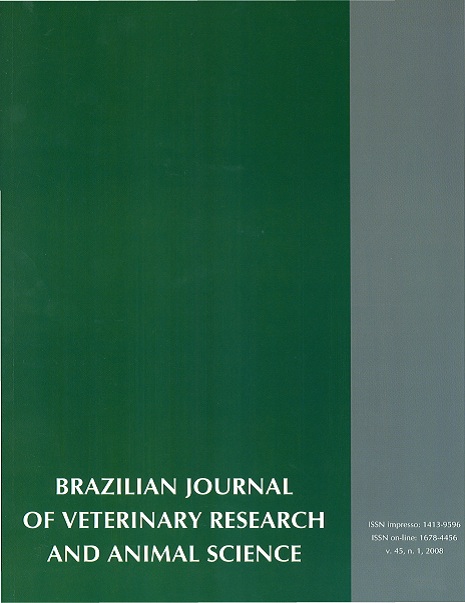FSH and LH profiles during follicle deviation in Nelore heifers (Bos indicus)
DOI:
https://doi.org/10.11606/issn.1678-4456.bjvras.2008.26714Keywords:
Gonadotropins, Pituitary, Nelore, Radioimmunoassay, CattleAbstract
Present study aimed to evaluate gonadotropins profiles in 12 Nelore heifers, in order to test the hypothesis that FSH concentrations decrease and LH presents a transient increase during follicle selection. Blood samples from jugular vein were harvested twice daily starting at the time of ovulation (D0) until D5. Plasma samples were assayed for FSH and LH by double antibody radioimmunoassay method. LH and FSH assay sensitivity was 0,02ng/ml and 0,005ng/ml, respectively. The intraassay coefficient of variation was 13,6% and 18,8%, respectively. Data (mean±SEM) were normalized to follicle deviation and analyzed by ANOVA and by linear, cubic, and quadratic regressions. Comparisons between higher and lower FSH values were also performed by T-test. There was no effect of time in plasmatic FSH and LH circulating levels when variance analysis or regression analysis were performed. However, by T-test, FSH concentrations reached the lowest plasmatic levels 36 (0,40±0,05ng/ml) and 60 hours (0,42±0,04ng/ml) after follicular deviation, comparatively to 36 hours before deviation, when the concentrations were maximal (0,63±0,08ng/ml). In conclusion, there is a FSH decrease, although a transient LH elevation has not been confirmed encompassing follicle deviation in Nelore females.Downloads
Download data is not yet available.
Downloads
Published
2008-02-01
Issue
Section
UNDEFINIED
License
The journal content is authorized under the Creative Commons BY-NC-SA license (summary of the license: https://
How to Cite
1.
Gimenes LU, Sá Filho MF, Torres-Júnior JR, Beltran MP, Nogueira G de P, Baruselli PS. FSH and LH profiles during follicle deviation in Nelore heifers (Bos indicus). Braz. J. Vet. Res. Anim. Sci. [Internet]. 2008 Feb. 1 [cited 2024 Apr. 19];45(1):11-6. Available from: https://revistas.usp.br/bjvras/article/view/26714





